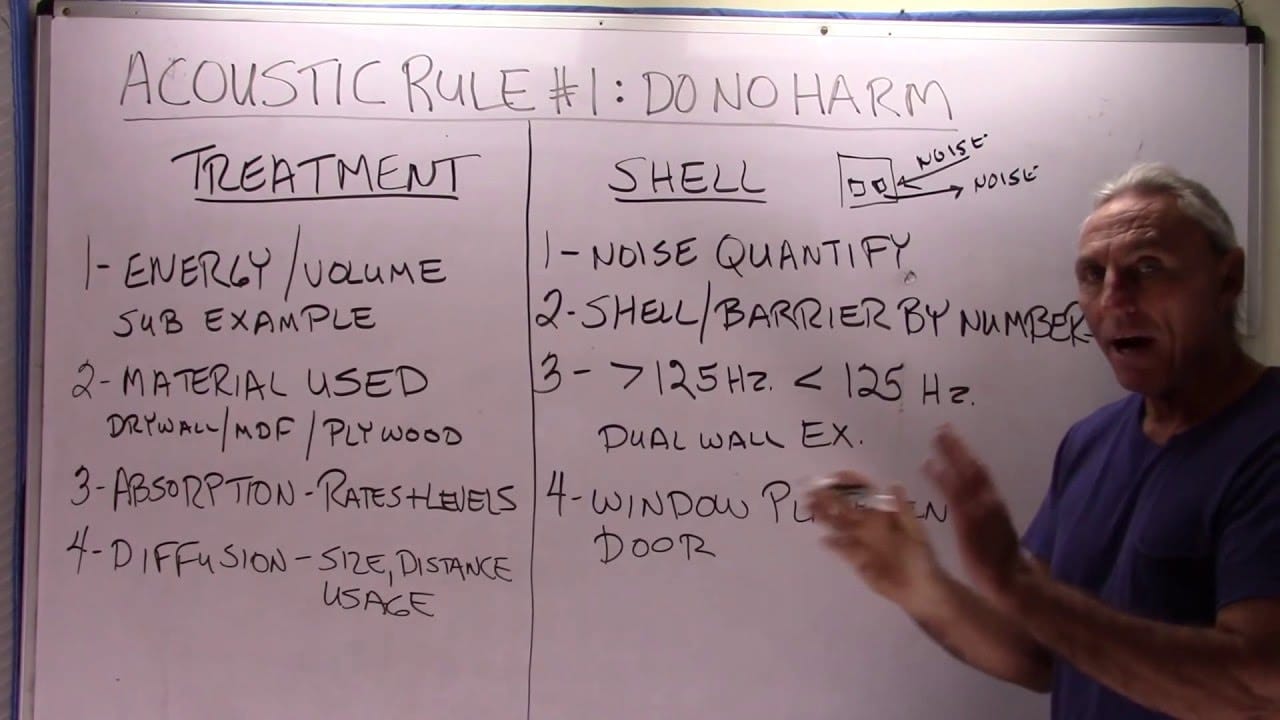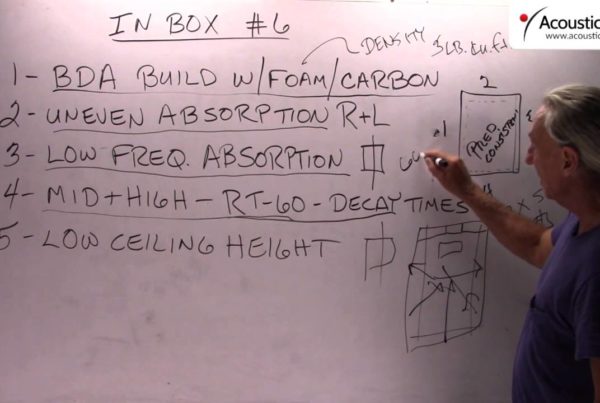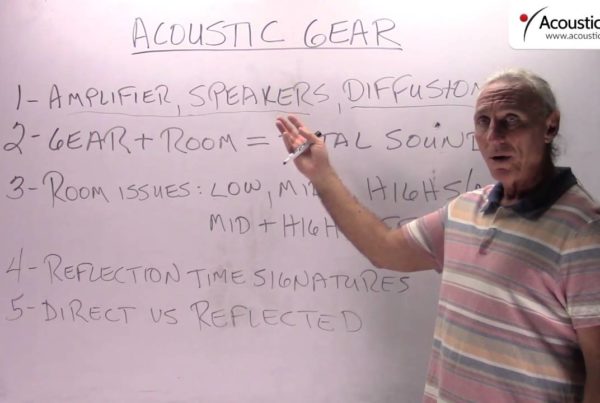Hi everyone, Dennis Foley from Acoustic Fields. I have been going through some of my notes and emails and I see a lot of the same issues repeating themselves. So I came up with a list of Acoustic Rules, I have about ten of them that we are going to outline and start today with.
The first rule of acoustics is like the mantra that physicians practice, and it’s the „do no harm“ rule. When you are building a building, we have two parts when you are building a room, two parts that we have to consider: we have the shell and we have the treatment. Both require special sciences, both require special materials, and both are really unique. There is some overlap in the disciplines, but the structures themselves are run by different rules, and people get these rules confused all the time. They think that treatment is a substitute for shell, and they confuse shell technologies or barrier technologies with treatment technologies a lot of times. And there is a lot of confusion on sound absorption being a shell type of treatment, which in most cases it’s not. So if we break our room into two parts, we have the treatments and the shell side. On the treatment side you must match the size and the volume to the usage, because the room is only so big. We can only put so much energy in it before the room starts to react to the excess energy. How does it react in the low frequency side? It reacts with motor pressures which are smothering and blurring a lot of another frequencies. So we have to match our energy and volume. Our energy output into the room and volume of the room to make sure its able to handle it. I get emails every day where people have small rooms and five subwoofers. I saw a room the other day that had 4 18s, 4 12s and 4 15s and it was no bigger than your average size room. So too much energy causes too many management issues inside the room. We have to marry the energy and the volume inside the room. The materials used inside the room have a direct impact on the sound quality of the room. A common material people use is the drywall, we don’t use it in any of our builds. MDF and Plywood have the same cost and are much better in terms of sound quality in your room. Another issue that we see constantly on the treatment side is absorptions rates and levels. People think that absorption is absorption. Nothing could be further from the truth when it comes to music and voice. The rate and levels of absorption that you use has a direct impact on the sound quality of your voice and music. Just ask any microphone. Microphones are very sensitive to rates and levels of absorption. So you have to match the rate and level of absorption to the usage, and a lot of the literature and a lot of the people have this misconception that building materials are good for voice and music – well they are not. They are not at the right rates and levels that you need for voice and music. Voice and music are special, they are different. You don’t use building installations with music.
Diffusion is another one. Diffusion has to be married to the usage. You have to pick the frequency response of the diffuser, how far is it from the listening position? What are we doing in the room, are we recording live music, are we recording voice? Is it a control room? Are we concerned with the reflections of the rear wall? Are we using absorption in the front part of the room and the diffusion in the rear? All of these things have to be taken into consideration on the treatment side.
The Shell side is the barrier that isolates our room from noise and also keeps the noise from going out, it has this double valve. It must keep the sound or the energy within the room, and keep the noise that’s external to the room from getting in to it. So this vibration transmission. This is controlling the vibration signature of the materials that you use. And the first thing that you have to do is not guess. You must quantify your noise issue through measurements. You must find out what the frequency is that’s causing the noise and how big it is. Because the measurements determine exactly what material you use in the barrier or the shell. So the numbers tell you exactly what to do. A lot of people guess at this, and they always guess wrong, because there is a direct correspondence to the frequency and the amplitude of the noise issues that you have and what materials you are going to use for the barriers. So we call it barriers by numbers. And you’ve got to qualify and measure them first. It’s not difficult, you can do it on an iPhone, and we can show you Apps to do that, it’s not complicated. For those that are really serious, you can do noise studies. But for most people’s usages there has to be a relationship between the amount of noise that you are trying to block from coming into the structure and the barrier that you use to block it. Here is a good example: barriers that are dealing with energy above the 125 cycles are a way different than barriers that are less than 125 cyclesThat’s the break point. The mass, the density, the arrangements of the materials become much more critical when you are dealing with lower frequency energy. So it’s all dependent on the numbers. You must know where the problem is, you must know how large the problem is in order to construct the correct barrier to solve the problem. Here is a common example we see all the time: „well i built two walls, I separated it from the air space, with the air space I hung drywall and I am not happy with the low end, it just goes right through it.“ Well it does, because it is that design to handle energy with less than 125 cycles . And this is another common thing in the literature that is not true. Window placement: You have to remember: – Do no harm! Window placement, door placement. You must be really careful about where you put these, because they have a direct impact on sound quality. And consistency and surface areas is really important. So the last thing we want on our mixing console, if there’s a channel in our seats, is a window here (on the left) and maybe a door here (on the right), or a window here (on the upper end) and a door here (on the right). So we have to be very careful where we place these things, and they are also noise sources. We have to be very careful about are they going to be strong enough, because noise is like water, it goes to the weakest part of our structures, and our windows and the doors are the weakest part of our structure. So treatment and shell, those are two issues when we are building rooms and if you are not building rooms you can still benefit from this analysis. And then the goal is not to do any harm, don’t do anything to make the situation worse. Do things that improve the situation. And if you are building you have that opportunity. It’s much easier to move a line on a piece of paper and drawing what you are going to build from than it is to move a wall after you built it and found out that it is not correct.
—
This is an unedited transcript from our video series from Acoustic Fields. There will be some errors in grammar and sentence structure that occur during this translation process.
For complete understanding and comprehension, please view the video which is included in this text. For any additional information regarding this topic or others relating to room acoustics, please contact us directly at:
P: 520 – 392 – 9486








We use broadband absorption in the two most critical frequency regions in small rooms. Our Diaphragmatic absorbers, ACDA series, have…
Interesting web site and provocative introduction. Please check your copy for typos, otherwise nicely presented. I would like to see…
There is no such thing as soundproof anything especially carpet. Low frequency noise transmission requires a permanent construction fix with…
Hello Dennis! Our neighbors put a Ice Bath in their garage which is right below our bedroom and the Low…